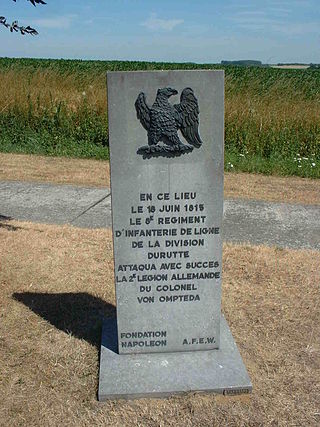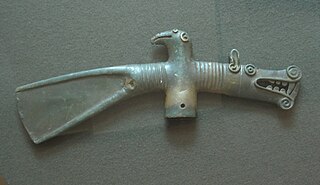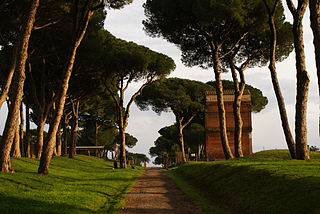
Kerameikos also known by its Latinized form Ceramicus, is an area of Athens, Greece, located to the northwest of the Acropolis, which includes an extensive area both within and outside the ancient city walls, on both sides of the Dipylon Gate and by the banks of the Eridanos River. It was the potters' quarter of the city, from which the English word "ceramic" is derived, and was also the site of an important cemetery and numerous funerary sculptures erected along the Sacred Way, a road from Athens to Eleusis.

A stele, from Greek στήλη, stēlē, plural στήλαι stēlai, is a stone or wooden slab, generally taller than it is wide, erected in the ancient world as a monument. The surface of the stele often has text, ornamentation, or both. These may be inscribed, carved in relief, or painted.

The tyet, sometimes called the knot of Isis or girdle of Isis, is an ancient Egyptian symbol that came to be connected with the goddess Isis. Its hieroglyphic depiction is catalogued as V39 in Gardiner's sign list.

Merneith was a consort and a regent of Ancient Egypt during the First Dynasty. She may have been a ruler of Egypt in her own right, based on several official records. If this was the case and the earlier royal wife Neithhotep never ruled as an independent regent, Merneith may have been the first female pharaoh and the earliest queen regnant in recorded history. Her rule occurred around 2950 BC for an undetermined period. Merneith’s name means "Beloved by Neith" and her stele contains symbols of that ancient Egyptian deity. She may have been Djer's daughter and was probably Djet's senior royal wife. The former meant that she would have been the great-granddaughter of unified Egypt's first pharaoh, Narmer. She was also the mother of Den, her successor.
Lisht or el-Lisht is an Egyptian village located south of Cairo. It is the site of Middle Kingdom royal and elite burials, including two pyramids built by Amenemhat I and Senusret I. The two main pyramids were surrounded by smaller pyramids of members of the royal family, and many mastaba tombs of high officials and their family members. They were constructed throughout the Twelfth and Thirteenth Dynasties. The site is also known for the tomb of Senebtisi, found undisturbed and from which a set of jewelry has been recovered. The pyramid complex of Senusret I is the best preserved from this period. The coffins in the tomb of Sesenebnef present the earliest versions of the Book of the Dead.

Tomb KV47, located in the Valley of the Kings in Egypt, was used for the burial of Pharaoh Siptah of the Nineteenth Dynasty. It was discovered on December 18, 1905 by Edward R. Ayrton, excavating on behalf of Theodore M. Davis; Siptah's mummy had been found earlier, cached in KV35. It was the last of the Nineteenth and Twentieth Dynasty kings tombs to be uncovered in the Valley. Ayrton stopped his excavation in 1907 due to safety fears, and Harry Burton returned in 1912 to dig further. The cutting of a side passage was halted after the workmen cut into Side Chamber Ja of the tomb of Tia'a (KV32). The tomb was unfinished at the time of its use.

The Ananyino culture is an archeological culture of the late 8th to 3rd centuries BCE in present-day Tatarstan, Russian Federation. The name comes from the burials first discovered near the village Ananyino (Ананьино) in the vicinity of Elabuga, excavated by P.V.Alabin and I.V.Shishkin in 1858.
The Yonggu Mausoleum is the mausoleum of Empress Feng (442–490), formally Empress Wenming and the wife of Emperor Wencheng of the Northern Wei dynasty of Chinese history. The tomb is located on a mountain about 25 kilometers from the city of Datong, in Shanxi Province. When her husband died in 465, Empress Dowager Wenming became regent until her stepson, Emperor Xiaowen, attained his adulthood. While Emperor Xiaowen assumed the imperial powers upon adulthood, she remained highly influential until her death in 490. Around this time, Buddhism became a state religion and Empress Dowager Wenming was responsible for the imperial shrines at Yungang Grottoes. There is evidence that Empress Dowager Wenming masterminded the transformation of the government and the sinification movement.
The majority of the 65 numbered tombs in the Valley of the Kings can be considered minor tombs, either because at present they have yielded little information or because the results of their investigation was only poorly recorded by their explorers, while some have received very little attention or were only cursorily noted. Most of these tombs are small, often only consisting of a single burial chamber accessed by means of a shaft or a staircase with a corridor or a series of corridors leading to the chamber, but some are larger, multiple chambered tombs. These minor tombs served various purposes, some were intended for burials of lesser royalty or for private burials, some contained animal burials and others apparently never received a primary burial. In many cases these tombs also served secondary functions and later intrusive material has been found related to these secondary activities. While some of these tombs have been open since antiquity, the majority were discovered in the 19th and early 20th centuries during the height of exploration in the valley.

The Abydos boats are the remnants of a group of ancient royal Egyptian ceremonial boats found at an archaeological site in Abydos, Egypt. Discovered in 1991, excavation of the Abydos boats began in 2000 at which time fourteen boats were identified. They are located alongside the massive mudbrick structure known as Shunet El Zebib, attributed to the 2nd Dynasty Pharaoh Khasekhemwy. Shunet El Zebib is one of several such "enclosure wall" constructions at this site dating back to the 1st Dynasty, and is located nearly one mile from the early dynastic royal cemetery of Umm El Qa'ab.

The Tombs of the Via Latina are Roman tombs, mainly from the 2nd century AD, that are found along a short stretch of the Via Latina, an ancient Roman road close to Rome, Italy. They are now part of an archaeological park and can be visited.

Several ancient Egyptian solar ships and boat pits were found in many ancient Egyptian sites. The most famous is the Khufu ship, which is now preserved in the Grand Egyptian Museum. The full-sized ships or boats were buried near ancient Egyptian pyramids or temples at many sites. The history and function of the ships are not precisely known. They are most commonly created as a "solar barge", a ritual vessel to carry the resurrected king with the sun god Ra across the heavens. This is a common theme in the Pyramid Texts, and these buried boats might be a real-life equivalent of solar barges. Similarly, another explanation behind these boats is that they were built for past kings to carry them to the afterlife. Because of these ships' association with the sun, they are often found in an east-west orientation in order to follow the path of the sun.
Nefer-Setekh is the name of an ancient Egyptian high official, who lived and worked either during the late midst of the 2nd or during the beginning of the 3rd dynasty. He became known by his name, which was addressed to the deity Seth.

The Northern Mazghuna Pyramid is an ancient Egyptian royal tomb which was built during the 12th or 13th Dynasty in Mazghuna, 5 km south of Dahshur. The building remained unfinished, and it is still unknown which pharaoh was really intended to be buried here since no appropriate inscription has been found.
Nisuheqet was an ancient Egyptian king's son of the Second Dynasty. Nisuheqet is only known from his stela found in tomb 964.H.8 at Helwan. The only title he bears on this monument is king's son. The stela is made of limestone and shows the prince on the left, sitting on a chair with an offering table and offerings in front of him. The stela was discovered in excavations by Zaki Saad at Helwan, that were conducted between 1952 and 1954. The royal father of this king's son remains unknown.
Khenmetptah was an ancient Egyptian king's daughter who lived most likely in the Second Dynasty. She is only known from her stela once placed in her tomb and found at Helwan. On the stela Khenmetptah is shown sitting on a chair in front of an offering table. Next to the offering table are shown many offerings. Above this scene is a short text: the king's daughter Khenmetptah. Her royal father is not known. On stylistical grounds the stela is datable to the Second Dynasty.
Satkhnum was an ancient Egyptian king's daughter who lived most likely in the Second Dynasty. She is only known from her stela once placed in her tomb and found at Helwan. On the stela Satkhnum is shown sitting on a chair in front of an offering table. Next to the offering table are shown many offerings. Above this scene is a short text: Satkhnum, the king's daughter. Her royal father is not known. On stylistical grounds the stela is datable to the Second Dynasty.
Meriiti was an ancient Egyptian official living at the end of the First Dynasty around 2900 BC. He is only known from his stela found in tomb 810.H.11 at Helwan. The stela was found in the burial chamber next to the coffin. It shows on the left Meriiti sitting on a chair with offerings in front of him. On the right side of the stela is a list of Meriiti's titles.
The Hunsrück-Eifel Culture is an Iron Age cultural group of the Middle Rhine region of western Germany (Rhineland-Palatinate) and eastern Belgium and Luxembourg. The names "Hunsrück" and "Eifel" refer to a pair of low mountain ranges covering most of the region.

Meni, Meny or Menankhpepy was an ancient Egyptian high official who lived during the reigns of Pepy I and Merenre Nemtyemsaf I, in the late Sixth Dynasty. Most of what is known about his life comes from his mastaba burial tomb in the Dendera Necropolis, a few hundred metres south of the Temple to Hathor. This tomb was explored during 1897 and 1898 by a team led by the British archaeologist Flinders Petrie.











